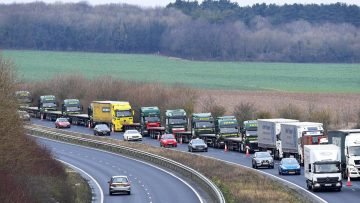
We hear a lot in the news recently about the potential for driverless cars and trucks to hit the roadways. There are already vehicles being tested, but there are mixed results and reactions. For example, there have been some accidents involving driverless vehicles.
The concept of driverless trucks is also something that has people in the trucking industry somewhat nervous. There is a lot to think about from job security to liability issues involving driverless trucks.
The following are some general things to know about driverless trucks and where they stand now.
What is a Driverless Truck?
The term driverless truck can sound a little daunting, but what does it entail in reality?
A driverless truck is one that can operate without a driver, but this is usually limited in certain situations. For example, they might not be able to operate in certain weather conditions. It can be compared to autopilot used on planes. California, Florida, and Nevada currently have legislation in place that allows for limited use of driverless trucks on the roadways, as part of the testing phase.
In Nevada, Freightliner is doing extensive and ongoing tests on certain areas of the highway.
At the current stage, driverless trucks do actually have a driver who can turn the feature on or off.
In some places, driverless trucks are already being used with no drivers, but not on public roads. Australia is an example, and the US Army also uses some Lockheed-Martin driverless trucks to deliver supplies and equipment.
What Are the Benefits of Autonomous Trucks for the Industry?
Some people do wonder why the trucking industry is pushing for the implementation of driverless or autonomous trucks, and there are some benefits to doing so.
One of the biggest reasons from the industry standpoint is the fact that they face a significant shortage of drivers. By 2022, there is expected to be a shortage of 240,000 drivers. Many baby boomer-age drivers are retiring, and these spots aren’t being filled.
There’s also the issue of accidents, many of which are fatal, that plague the trucking industry. Often these accidents are the result of human error ot not fully understanding the Air Brake functionality., frequently because of tired drivers. The costs of those accidents are tremendous, and the idea is that autonomous trucks could help reduce driver fatigue by allowing them less driving time during their shifts.
Of course, the unfortunate part for truckers is that another motivation from trucking companies is to improve their profitability and reduce what they pay drivers.
Will Driverless Trucks Take Jobs?
The idea of automation as one that “steals” jobs certainly isn’t new. It has been a concern among employees for decades. There are millions of people in the U.S. that rely on trucking as their work.
While there is the potential for driverless trucks to change the demand in the industry for drivers, this does have to be weighed against the current driver shortage.
Additionally, the role of a truck driver may shift instead of disappearing. For example, truck drivers may be focused on paperwork, scheduling, and logistics more so than driving.
Along with the possible increased unemployment in the trucking industry, other potential pitfalls of this technology include security risks. With driverless trucks, there’s the possibility of hackers to break into systems, which could lead to serious problems.
Inclement weather remains a big issue as well. As it stands right now, autonomous driving has only been tested in good weather condition, and it will take some time before testing moves into the realm of poor weather conditions.
With driverless cars and trucks, there is also still the need to figure out how to program these vehicles to deal with the unexpected, such as something appearing in the middle of the road. It can be difficult for autonomous systems to handle the unexpected as a human driver can.
Who Has Liability If There’s an Accident?
Finally, companies like Tesla have already had to delve into the concept of liability when there’s an accident involving driverless technology, as has Google. For example, in 2016, a Google self-driving vehicle collided with a bus when it moved into the center lane to avoid sandbags. When there’s an accident and it’s not the fault of human error, there is a question of who is responsible.
It may be that truck manufacturers shoulder much of this burden, but the industry and the concept will likely have to evolve and more will have to play out for this to become clearer and less of a gray area.
This is an article provided by our partners network. It might not necessarily reflect the views or opinions of our editorial team and management.
Contributed content

Founder Dinis Guarda
IntelligentHQ Your New Business Network.
IntelligentHQ is a Business network and an expert source for finance, capital markets and intelligence for thousands of global business professionals, startups, and companies.
We exist at the point of intersection between technology, social media, finance and innovation.
IntelligentHQ leverages innovation and scale of social digital technology, analytics, news, and distribution to create an unparalleled, full digital medium and social business networks spectrum.
IntelligentHQ is working hard, to become a trusted, and indispensable source of business news and analytics, within financial services and its associated supply chains and ecosystems




























